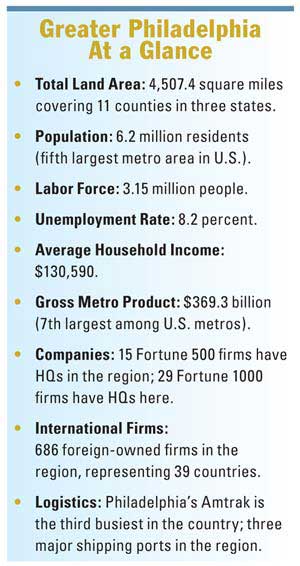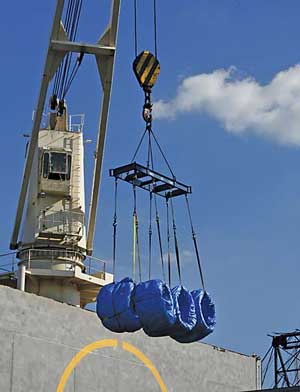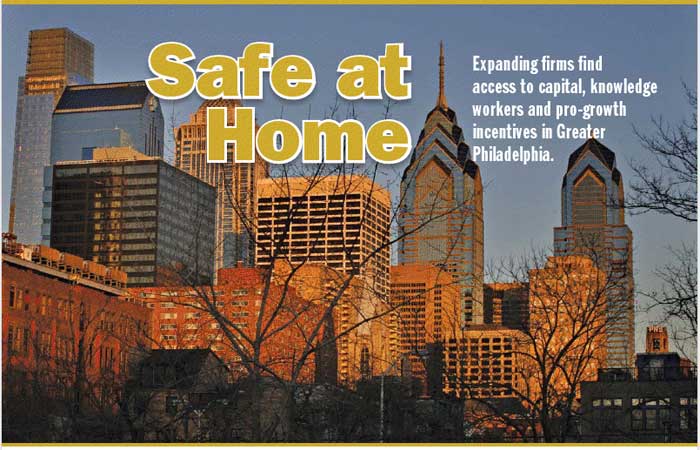The rapid rise of the Power Home Remodeling Group, the fourth largest home remodeling company in the U.S., is a microcosm of the Philadelphia economy.
With three-year growth of 367 percent during the nation’s worst recession since the Great Depression, Power Home is emblematic of the resiliency and innovation that has long characterized the Greater Philadelphia region.
When the company moved into 58,000 sq. ft. (5,388 sq. m.) of space earlier this year in the Wharf at Rivertown in the city of Chester, the relocation only confirmed what co-founder and CEO Jeff Kaliner already knew: “This is our home.”
That home is Greater Philadelphia, an 11-county metro region of 6.236 million residents including a labor force of 3.15 million workers. With a gross metro product of $369.3 billion in 2010, the region ranks seventh largest in the U.S.
The area also boasts an affordable cost of doing business that is much less than New York, Boston and Washington, D.C.
“We are growing so rapidly and aggressively that we are opening new operations and locations up and down the East Coast,” says Kaliner, whose firm moved from its former home of 17,500 sq. ft. (1,626 sq. m.) in Brookhaven. “Philadelphia offers a lot of great things. The city has come a long way. It is cleaner and safer today than ever. The restaurants are great. There are colleges wherever you turn. And the business climate gives us the opportunity to sell our products and services to the fifth largest metro in the country.”
The firm’s $1-million capital investment will result in the creation of 270 jobs within three years in Chester, a suburb that is undergoing a major revitalization.
“We made plans to really grow beginning in 2005,” says Kaliner. “We wanted to become best in class on a lot of fronts, and we made the decision to move to Chester for a few reasons.”
Among those reasons were lucrative tax incentives provided by the Commonwealth of Pennsylvania through the Keystone Opportunity Zone program, an additional $200,000 state grant that enabled Power Home to buy new furniture, and a logistics-friendly site at Interstate 95 and Highway 476.
“We also liked the fact that we could become part of the revitalization of Chester,” Kaliner says. “We see that as a positive. There is a great hospital here. The Philadelphia Union MLS soccer team is right across the street from us, and there are good universities here.”
The most important location advantage, however, is proximity to customers, notes Kaliner. “You don’t have to go that far to reach a large population. Being based in Philly has enabled us to expand into other markets because our business has never suffered at home. We have substantially grown our home base while planting seeds in other markets.”
With 900 total employees and $132 million in sales last year, Power Home has set a target of achieving $1 billion in sales within 10 years.
Educated Work Force Beckons Firms
The company’s formula — pursuing steady growth at home while looking to enter new markets elsewhere — is a recipe that appears to be working well for many companies in the Greater Philadelphia region.
“The city’s economy today is in a great position,” says John Grady, president of the Philadelphia Industrial Development Corp. “We remained relatively stable through the recession. We have not seen the extremes in our economy. We have a very diverse economy across many sectors. Education and medicine are two of our strongest sectors, and the quality of life in the city has really become a driver of companies that value a highly educated work force.”
With 101 colleges and universities in the region, nearly 380,000 people attend classes at an institution of higher learning somewhere in the area. More than 80,500 certificates and degrees are awarded by these schools each year, with 78.6 percent of these honors being a bachelor’s degree or higher.
Knowledge-based companies covet this work force, notes Grady, who adds that “the city and the business community have been smart to invest in new sectors of the economy. Our education sector and tourism-hospitality sector have allowed for this transition to an economy that is much more diversified.”

Even as the surrounding suburbs grew rapidly, the core of Philadelphia never lost its industrial base, says Grady. “We retained a large segment of our industrial base because we had an existing infrastructure in the center city that is very conducive to moving people in and out of the city very quickly,” he says. “We have always maintained a strong urban core with strong amenities. As a result, we are seeing more employers who want to attract a young, highly educated labor force.”
Corporate facility expansions in Philadelphia continue at a big-city pace. Liberty Property Trust recently broke ground on a new office complex for GlaxoSmithKline at the Navy Yard. The $300-million development will include 220,000 sq. ft. (20,438 sq. m.) of new space and bring about 1,300 jobs.
Urban Outfitters, which already has 350,000 sq. ft. (32,515 sq. m.) at the Navy Yard, is adding another 100,000 sq. ft. (9,290 sq. m.) and hiring 1,000 more people over the next two years. “They have already invested $140 million into the headquarters campus, and this new project will be another $30-million investment,” Grady says.
In northeast Philadelphia about two blocks from the Northeast Airport, MPC just opened a 111,000-sq.-ft. (10,312-sq.-m.) facility for the zero-landfill recycling of electronics.
“We have been working in Philly for a long time, and a major driver of this project was the help we received from the good people of Philadelphia,” says David Kutoff, president and CEO of the Mendota Heights, Minn.-based firm. “The final site selection came down to logistical approaches. The actual size of the facility was a key consideration. It was driven by customer demands.”
Kutoff notes that MPC started with 15 people, “but we are up to 100 now and will go up to 250 employees upon full production. The city’s willingness to help us train employees as they come on line was crucial.”
Kutoff says the Philadelphia business climate gives his firm a lot of advantages. “It is a nice business community with a lot of organizations that help,” he says. “We are excited to be in the area and we are excited about the openness and the welcoming that we received here.”
‘City is Sensitive to Business Issues’
Grady says the PIDC works hard to keep improving that business climate. “We have acquired and sold more than 3,000 acres [1,215 hectares] of land and 10 industrial parks,” he notes. “We are redeveloping the Navy Yard as a 1,000-acre (405-hectare), mixed-use business campus. Our primary focus is on managing real estate and lending resources, attracting capital and acquiring property, and acting as a conduit between the public sector and private industry.”
Grady adds that “we have a whole lending team that functions as a public sector bank. We lend money to people who are building new facilities and creating jobs in the city. We bridge the financing gap for companies. We work with everyone from small manufacturers to large companies.”
Alan Greenberger, deputy mayor for economic development and director of commerce for the City of Philadelphia, tells Site Selection that “philosophically, government is not in the business of manufacturing jobs. We are in the business of making Philadelphia an attractive business environment.”
Greenberger notes that “the city is sensitive to business issues. People don’t always have the right perception of Philadelphia. We tend to rely on pandered narrative. But cities are not what we think they are. Philadelphia has a long and deep and powerful tradition of manufacturing. And the heart of the Philadelphia economy is our colleges and universities. We and Boston are the two cities richest in institutions of higher education and centers of clinical and medical research. There are four major teaching hospitals in the city.”
The hospitality industry of the city is also growing, he says. “Thanks to the recent expansion of the Pennsylvania Convention Center, we are growing as a convention city,” he adds. “It is a broad-based economy. We have jobs at the high end and the low end. The good news is that the Philadelphia market economy did not diminish to the extent that it did in other cities. Our real estate market did not drop to the degree that it did in other cities.”

The current unemployment rate of the Philadelphia area is around 8 percent, “but it is relatively stable,” says Greenberger. “We are increasingly a city that is extremely attractive to young people. The cost of housing is lower here than in other cities along the Northeast Coast. Philadelphia is a very social city that attracts younger people and the employers who need them.”
Many of those employers are staffing up. Aker Shipyard, for example, just signed a contract with ExxonMobil to build two new double-hulled tankers, generating 1,000 new jobs. Each ship will cost about $200 million.
“Serious effort between the city, state, PIDC and Aker resulted in a program to keep the shipyard going,” Greenberger says. “That investment is proving itself the right thing to do.”
The city also attracted Teva Pharmaceutical Industries, the largest generic drug company in the world. “Teva is an Israeli company that will invest $295 million into a robotic distribution facility in the city,” he says. The project will result in 366 new jobs and 1.2 million sq. ft. (111,480 sq. m.) of new space.
On the institutional side, several medical complexes are expanding as well. “We have Children’s Hospital of Philadelphia, which is expanding like crazy, and Drexel University is looking at growing too,” says Greenberger.
On the Go:
From Bicycles to Helicopters
In the suburbs, businesses are thriving too. “Our philosophy is not business attraction; it is growing companies,” says Gary Smith, president and CEO of the Chester County Economic Development Council. “Whether you are an Amish farmer or an advanced technology company, we will work with you. Every business needs capital to sustain itself, and we do a lot of fixed asset lending. We have learned to create a business opportunity for ourselves.”
Smith says the City of Coatesville may be the poster child for Chester County’s resurgence. An old steel manufacturing community that has seen its labor force shrink dramatically over the past 25 years, Coatesville will soon be the home of the National Velodrome Center.
Scheduled to open in late 2012, the NVC will be the first world-class indoor velodrome for bicycle racing on the East Coast. “It is an exciting project and a tremendous redevelopment opportunity,” Smith says. “This will be a training site for people around the country who are training for the Olympics.”
Smith notes that “we had over $41 million in private investment in projects in Chester County in the past year. Over 300 jobs were committed and more than 200,000 sq. ft. [18,580 sq. m.] of new space was added in flex and office space.”
One of the largest investments was just announced in July, when West Pharmaceuticals said it would build a new facility in Chester County for its international headquarters. “The loans on this project were close to $40 million,” says Smith. “This 100,000-sq.-ft. [9,290-sq.-m.] building will be a state-of-the-art green facility.”
Other developments in the county include a 26-acre (10.5-hectare) solar farm being developed in Morgantown. “We have created a very aggressive program here to support alternative energy companies,” adds Smith. “We even got into the training of proper installers.”
The county also landed PPD, a national contract research organization, in Wayne. The firm will invest $25 million and hire 85 new workers in drug discovery and life-cycle management. “We have a lot of life science activity here now, and we keep growing,” Smith says.
Sikorsky, the global helicopter manufacturer, recently acquired a smaller company in Chester County and grew it from 50 to about 1,000 employees, says Smith.
“We have worked with over 900 companies, and our pipeline is full,” he adds. “We try to show young people that there is a future of employment here in Chester County. We are very entrepreneurial.”

In Bucks County, the Keystone Industrial Port Complex is a former U.S. Steel site that is attracting industrial companies from around the world. Under the management of USS Real Estate, KIPC “is moving well ahead, even during the recession,” says Rick Leighton, senior vice president of corporate services for NAI Global.
“We have been bringing new people in because we have some capabilities that make it attractive for unique distribution opportunities. We have a deepwater port for break-bulk material, and we have rail capability served by both Norfolk Southern and CSX. We have great highway access, and we have access to the population to support the jobs that are there.”
In July 2010, CSC Sugar leased the 161,000-sq.-ft. (14,957-sq.-m.) Bar Mill building on site to import raw sugar in bulk via ship and rail, and then refine the sugar into a liquid product.
“We have a company making poly-silicon on site, and wind energy manufacturer Gamesa has 100 acres on site,” adds Leighton. “Now we are getting some alternative energy businesses looking at the site for the recycling of materials to make cleaner fuel.”
In Montgomery County, the life sciences sector continues to provide a steady flow of pharmaceutical, biotech and medical device manufacturing projects.
“The technical work force that we have here is very attractive,” says Carmen Italia, president of the Montgomery County Economic Development Corp. “We are the number one manufacturing county in the state, and we are the second most populated county in the Greater Philadelphia area.”
Recently announced projects in the county came from Globus Medical and Quest Diagnostics. Globus added 105 workers at its R&D campus in Audubon, while Quest added 137,000 sq. ft. (12,727 sq. m.) at its medical testing operation in Lower Providence.
“Globus was started here by two local guys,” says Italia. “Today, they do over $300 million in sales and employ more than 500 people.”
This investment profile was prepared under the auspices of the economic development partners of Southeastern Pennsylvania. For more information, contact Erin Murphy Boyle of the Southeastern Pennsylvania Governor’s Action Team Office.
(215) 560-5822 ermurphy@pa.gov www.newpa.com www.visitpa.com
